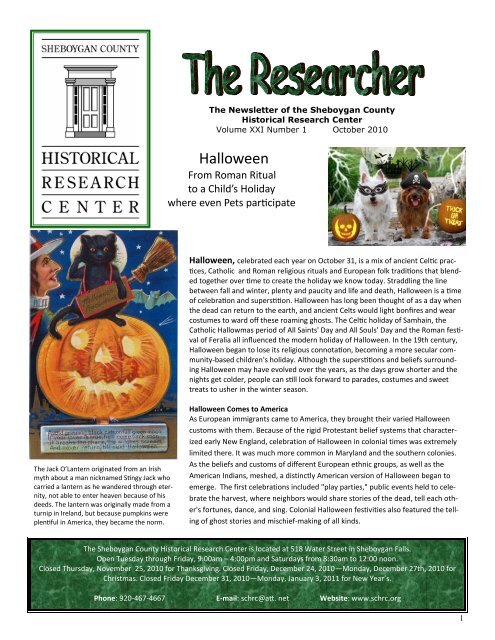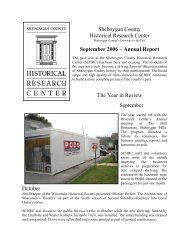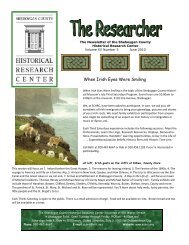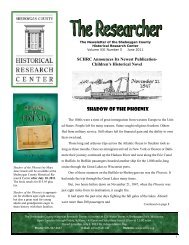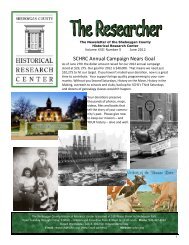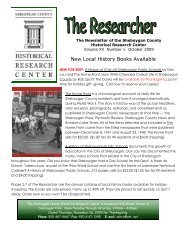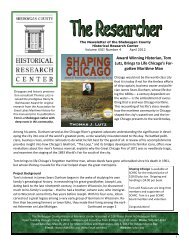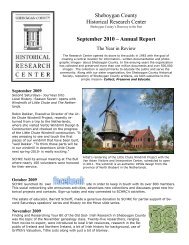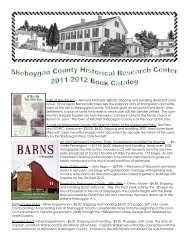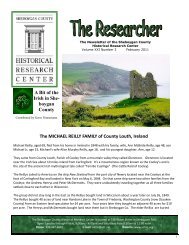October 2010 - Sheboygan County Historical Research Center
October 2010 - Sheboygan County Historical Research Center
October 2010 - Sheboygan County Historical Research Center
Create successful ePaper yourself
Turn your PDF publications into a flip-book with our unique Google optimized e-Paper software.
The Newsletter of the <strong>Sheboygan</strong> <strong>County</strong><strong>Historical</strong> <strong>Research</strong> <strong>Center</strong>Volume XXI Number 1 <strong>October</strong> <strong>2010</strong>HalloweenFrom Roman Ritualto a Child’s Holidaywhere even Pets participateHalloween, celebrated each year on <strong>October</strong> 31, is a mix of ancient Celtic practices,Catholic and Roman religious rituals and European folk traditions that blendedtogether over time to create the holiday we know today. Straddling the linebetween fall and winter, plenty and paucity and life and death, Halloween is a timeof celebration and superstition. Halloween has long been thought of as a day whenthe dead can return to the earth, and ancient Celts would light bonfires and wearcostumes to ward off these roaming ghosts. The Celtic holiday of Samhain, theCatholic Hallowmas period of All Saints' Day and All Souls' Day and the Roman festivalof Feralia all influenced the modern holiday of Halloween. In the 19th century,Halloween began to lose its religious connotation, becoming a more secular community-basedchildren's holiday. Although the superstitions and beliefs surroundingHalloween may have evolved over the years, as the days grow shorter and thenights get colder, people can still look forward to parades, costumes and sweettreats to usher in the winter season.The Jack O’Lantern originated from an Irishmyth about a man nicknamed Stingy Jack whocarried a lantern as he wandered through eternity,not able to enter heaven because of hisdeeds. The lantern was originally made from aturnip in Ireland, but because pumpkins wereplentiful in America, they became the norm.Halloween Comes to AmericaAs European immigrants came to America, they brought their varied Halloweencustoms with them. Because of the rigid Protestant belief systems that characterizedearly New England, celebration of Halloween in colonial times was extremelylimited there. It was much more common in Maryland and the southern colonies.As the beliefs and customs of different European ethnic groups, as well as theAmerican Indians, meshed, a distinctly American version of Halloween began toemerge. The first celebrations included "play parties," public events held to celebratethe harvest, where neighbors would share stories of the dead, tell each other'sfortunes, dance, and sing. Colonial Halloween festivities also featured the tellingof ghost stories and mischief-making of all kinds.The <strong>Sheboygan</strong> <strong>County</strong> <strong>Historical</strong> <strong>Research</strong> <strong>Center</strong> is located at 518 Water Street in <strong>Sheboygan</strong> Falls.Open Tuesday through Friday, 9:00am – 4:00pm and Saturdays from 8:30am to 12:00 noon.Closed Thursday, November 25, <strong>2010</strong> for Thanksgiving. Closed Friday, December 24, <strong>2010</strong>—Monday, December 27th, <strong>2010</strong> forChristmas. Closed Friday December 31, <strong>2010</strong>—Monday, January 3, 2011 for New Year’s.Phone: 920-467-4667 E-mail: schrc@att. net Website: www.schrc.org1
By the middle of the nineteenth century, annual autumnfestivities were common, but Halloween was not yet celebratedeverywhere in the country.In the second half of the nineteenth century, America wasflooded with new immigrants. These new immigrants, especiallythe millions of Irish fleeing Ireland's potato famine of1846, helped to popularize the celebration of Halloweennationally. Taking from Irish and English traditions, Americansbegan to dress up in costumes and go house to houseasking for food or money, a practice that eventually becametoday's "trick-or-treat" tradition. Young women believedthat, on Halloween, they could divine the name or appearanceof their future husband by doing tricks with yarn, appleparings, or mirrors.By the middle of the nineteenth century, annual autumnfestivities were common, but Halloween was not yet celebratedeverywhere in the country.Eventually, there was a move in America to mold Halloweeninto a holiday more about community and neighborly gettogethers,than about ghosts, pranks, and witchcraft.At the turn of the 20th century, Halloween parties for bothchildren and adults became the most common way to celebratethe day. Parties focused on games, foods of the season,and festive costumes. Parents were encouraged bynewspapers and community leaders to take anything"frightening" or "grotesque" out of Halloween celebrations.Because of their efforts, Halloween lost most of its superstitiousand religious overtones by the beginning of the twentiethcentury.By the 1920s and 1930s Halloween had become a secular,but community-centered holiday with parades and townwideparties as the featured entertainment.Despite the best efforts of many schools and communities,vandalism began to plague Halloween celebrations in manycommunities during this time. By the 1950s, town leadershad successfully limited vandalism and Halloween hadevolved into a holiday directed mainly at the young. Between1920 and 1950, the centuries-old practice of trick-ortreatingwas also revived. Trick-or-treating was a relativelyinexpensive way for an entire community to share the Halloweencelebration. In theory, families could also preventtricks being played on them by providing the neighborhoodchildren with small treats. A new American tradition wasborn, and it has continued to grow. Today, Americans spendan estimated $6.9 billion annually on Halloween, making itthe country's second largest commercial holiday.SCHRC Wish List– Paper towels, clear or blue plasticgarbage bags and Lysol wipes.5th AnnualCeltic Christmas TeaNollaig shona. Merry Christmas– a bitearly, I know, but it’s time to markyour calendars. The holiday season isalways busy, but be sure not to missthe 5th annual Celtic Christmas tea scheduled for Saturday,December 4, <strong>2010</strong>. The event will be held at the Plymouth<strong>Historical</strong> Society, 420 East Mill Street, Plymouth, WI from1:00pm to 3:00pm. Entertainment will be provided byO’Connor and Theiss.This is a collaborative Irish/Christmas program sponsored bythe <strong>Sheboygan</strong> <strong>County</strong> <strong>Historical</strong> <strong>Research</strong> <strong>Center</strong>, the <strong>Sheboygan</strong><strong>County</strong> Chapter of Celtic Women International andthe Plymouth <strong>Historical</strong> Society.Christmas treats, traditional brown bread, tea and coffeewill be served in addition to the great music and even betterconversation. A donation of $3 per person is requested tohelp cover costs of the entertainment. This event is open tothe public. Snow date is scheduled for Saturday, December11, <strong>2010</strong>. Call 920.467.4667 for questions.MARK YOURCALENDARS!!!The Association for the Advancementof Dutch-AmericanStudies (AADAS) will hold its18 th biennial meeting at LakelandCollege from June 9-11,2011. A pre-conference tour istentatively scheduled onWednesday, June 8 to visit thenew windmill in Little Chute andtour the community. The tour will be hosted by the LittleChute Windmill, Inc. and the Little Chute <strong>Historical</strong> Society.The conference theme is “Past and Present: The Importanceof History for Dutch-Americans.” The presentations willaddress Wisconsin’s place in Dutch-American history andthe ongoing interest in Dutch identity across the UnitedStates. We are hopeful that there will also be sessions thatinclude connections and comparisons between the Dutchand the German and Scandinavian immigrants.The <strong>Research</strong> <strong>Center</strong> will be hosting this conference andMary Risseeuw is the local host and organizer. If you haveany questions, wish to be on the mailing list for the event,or are willing to assist with conference planning, pleasecontact Mary at 467-4667 or at maryr.schrc@att.net.2
The Goetz Family of BavariaExcerpt from Ploughs Among the Eskers, by Bernard MichaelsNewly-married Christopher and Margaret Goetz emigrated from their native Bavaria in thelate 1830s. Upon arriving in America, they initially settled in the Sandusky Valley of Ohio. Theyoung couple lived for a number of years in this flood-prone region, giving birth during thistime to five children, but in 1847 they packed their wagon and moved to Wisconsin Territory.After passing through Milwaukee Goetz and family followed the lakeshore trail to <strong>Sheboygan</strong>only to find on his arrival most of the surrounding area was already settled or file on. At thevillage land office, however, he was informed of an available of government land located in aregion of hills some twenty miles to the west. Leaving Margaret and children at the villagewith the wagon, Goetz headed inland on foot following a well-beaten Indian trail. His searchfor land ended late that afternoon in the southwest corner of township fourteen, range twenty.(Mitchell) Here, the forested upland interspaced with numerous small lakes offered timberfor building and fuel, well-drained, but hilly, farmland and a plentiful supply of water. Upon his return to the land office Goetz laidclaim to a one hundred and twenty acre parcel in section thirty-one. Later he would add another eighty to these holdings. Thechain of lakes included in this land purchase remains known in the Kettle Moraine Forest as the Kelling Lakes area.The small mill settlement of Cascade lay on the trail some six miles east of the land Christopher filed on. While passing through it,the Goetzs chanced to meet the Kaiser family, who had recently arrived from Baden. The Germans welcomed the opportunity toconverse in their native tongue and invited Margaret and the children to stay with them while Christopher prepared living quarterson the claim. Securing the aid of a Mr. Preston from the community, Goetz unloaded his heavily burdened wagon at the settlement,storing the furniture and agricultural tools in an unused school building. Upon proceeding to the farm site, the men “rolledup” the log shanty with all due haste, a fact which apparently produced some negative effect on its appearance. Two weeks laterwhen the children were brought from Cascade to view their new home for the first time, they mistakenly identified it as the horsestable. As soon as they had moved into their cabin, the family turned their efforts to the preparation of cropland. During the remainingweeks of summer they managed to clear a two-acre patch near the building which was hand-sown with winter wheat thatSeptember.The Goetzs had arrived in the Kettle with three horses. Soon finding these unequal to the task of clearing and breaking the virginsoils, Christopher journeyed to <strong>Sheboygan</strong> Falls, retuning with a yoke of young bullocks. Although exasperatingly slow-moving, thepowerful animals soon proved able to handle the heaviest workloads. Previously, when the breaking plow had become snagged onsome unseen root or boulder, the high-strung horses often bolted, damaging both plow and harnesses. Now the more docile oxen,on sensing the additional strain, merely stopped pulling and calmly chewed their cuds while Christopher and sons cleared the obstaclefrom the plow point.In the early years, the family’s closest neighbors were members of a small Indian band who lived on the nearby lakes. Althoughalways ready to bargain for food or tobacco, the good-natured natives presented few problems for the Goetzs. Wild game wasplentiful and duck, wild pigeon and venison made up a major part of the family menu. Also numerous was the gray wolf, often runningin packs of twenty or more animals. During the long winter nights they frequently gathered near the cabin, making the smallbuilding’s interior unbearable with their howling, while the morning’s light revealed the surrounding snow covered with their circlingtracks. Somehow the wolves always appeared famished and Goetz took great care to see that the stable and pigsty were securelyfastened each evening. While not as brazen as the wolves, bear were also a nuisance to the farmstead. They were often seensunning their cubs at the edge of the clearing and occasionally would dine on a pig that ventured into the woods after acorns.The winter wheat flourished on the newly broken soils. In the second summer the ripened grain was cradled and bound, then takeninto the small barn. After being spread on the split-log floor the wheat was flailed and then winnowed to separate the chafffrom the kernels. A few weeks later the grain was hauled to Cascade, the mill there being the closest to the Goetz farm. ChristopherGoetz was a progressive farmer and by the time the next harvest came around he had replaced his flail with a new threshingmachine. Said to be the first of its kind in <strong>Sheboygan</strong> <strong>County</strong>, the treadmill-powered machine sold for three hundred dollars in1850, which was a considerable sum of money for a frontier farmer to spend on machinery.By 1860, the Goetzs, now numbering eleven members, had cleared the oak and maple cover from more than forty acres of theirland. The expansive area allowed them a harvest of wheat, oats and Indian corn that year totaling nearly five hundred bushel. Thestable-yard was occupied by ten cattle and nine swine– the bears didn’t get them all– while a small flock of sheep nibbled on slopestoo steep for even Christopher and the bullocks to plow. (Continued on page 6)3
Oral Histories: Wisconsin Survivors of the HolocaustTaken from www.wisconsinhistory.orgSix million European Jews were systematically murdered by the Nazis and their allies during the1930s and 1940s. This persecution of Jews is known as the Holocaust. As Nazi tyranny spread, millionsof other people were also killed by the Third Reich. About 140,000 Holocaust survivors came tothe U.S. More than 1,000 eventually settled in Wisconsin.Wisconsin <strong>Historical</strong> Society archivists interviewed 22 Holocaust survivors and two American witnessesbetween 1974 and 1981. These oral histories are now available digitally and in their entirety forthe first time, uncensored and unfiltered. (www.wisconsinhistory.org) Three short vignettes follow.Lucy Rothstein Baras was born in Skalat, Poland (Ukraine), on August 15, 1913. She was the oldestchild in the family of an Orthodox Jewish leather merchant. After graduating from high school, she attended law school inLwow. A 1933 law prohibiting Jews from practicing law forced her to abandon her schooling. Instead, Lucy learned the tailoringtrade and returned to Skalat to open her own shop.The Jews of Skalat lived in relative safety until July 4, 1941, when Nazi forces overran the city. They killed about 400 men, includingher father. The Rothstein family continued to survive by working for the Germans in the family leather shop makingshoes for concentration camp workers. A short time later a Jewish ghetto was established in the family's neighborhood in Skalat.Its borders continued to shrink following numerous "actions" in which thousands were murdered.In early 1943 the family was forced to leave their home and work at the labor camp established in Skalat. Lucy was appointedthe personal tailor to the Nazi overseer of the county. Lucy's husband-to-be, Edward Baras, was the overseer's farm administrator.In the summer of 1943, Lucy, her mother, and her brother escaped to the forest, where they hid for three weeks. Duringthat time, her mother failed to return while searching for food. She was never seen again. Lucy and her brother joined a groupof Jews hiding deeper in the woods. They remained there until their liberation by the Russian army at the end of 1943. Afterliberation, they traveled through Zbaraz, eventually to return to Skalat in early 1944 where she immediately reunited with Edward.The two were wed and a son was born in 1945.Fearing similar persecution under the communist regime, Lucy and her family fled the Ukraine soon after their son was born.They were captured in Czechoslovakia, but escaped to a displaced persons camp at Bamberg, Germany, where they were interreduntil 1950. After leaving Germany, the Baras' spent nine months in New York before arriving in <strong>Sheboygan</strong>, Wisconsin.They joined Edward Baras' brother and sister, who were relocated to <strong>Sheboygan</strong> directly from Germany. Edward worked as amachinist at the Kohler Company until his retirement in 1974. Lucy worked as a part-time tailor for many years. She died in February2002.Rothstein Home, 1925 Baras Family, 1949Survivors Rothstein Baras Family 1949Other Local Resources- <strong>Sheboygan</strong>’s own Mead Public Library established a Jewish Holocaust Collection in 2001for consultation and use by the public. It is located in the Fela and Anschel Warschau Room. The purpose of the collection is tocollect and make available for researchers materials about the Holocaust contributed from the personal collections and files of<strong>Sheboygan</strong> residents who survived the Holocaust and its aftermath. Generous support from community members enabled theLibrary to introduce the collection with 150 cataloged items along with numerous documents and photographs, some of whichare displayed in the Warschau Room. Donors are listed in a commemorative booklet available at Mead Library.4
Louis Koplin (born Ludwig Kopolowitz) was born in Nelipeno,Czechoslovakia (now in the Ukraine), on July 30, 1920. He camefrom a family of Orthodox Jews who had lived in an area knownas Subcarpathian Ruthenia for hundreds of years. Louis graduatedfrom the Munkacs Gymnasium in 1941, two years afterthe German-sympathizing Hungarian government occupiedSubcarpathia.Although the Hungarian government did not persecute theJews until the spring of 1944, Jewish men were sent to the Russianfront beginning in June 1941 to mine and dig trenches. Louis was sent to a laborcamp in Komarom, Hungary. He was chosen from among 2,000 men to remain there as ashoemaker. The others were never heard from again.Louis remained in Komarom until March 1944, when the Hungarians abandoned thecamp after the Nazis invaded Hungary. Louis was rounded up and sent to the Austrianborder, where he worked in a forced labor camp until February 1945. He was then forcemarchedwith thousands of others for more than 300 miles to the concentration camp ofMauthausen. More than 95 percent of the prisoners died en route. Soon afterward theNazi guards fled the camp, leaving the inmates on their own until they were liberated bythe advancing U.S. Army several days later.Upon his arrival at a displaced persons camp in Germany, Louis was hired by the AmericanJewish Joint Distribution Committee (JDC) to help resettle refugees throughout Europe.Through the JDC, he was accepted at the University of Wisconsin - Madison, wherehe arrived in September 1947. Louis studied pharmacy and moved to Milwaukee aftergraduating. Louis married in 1954, opened a pharmacy in 1957, and raised three children.Louis retired in 1992.* * * * * * * * *A suffering young girl atMauthausen concentration camp inMay of 1945 at the time of thecamp’s liberation. SCHRC collection.Rachel (Rosa) Goldberg Katz was born in Lodz, Poland, on May 6, 1924, to a well-to-do family withliberal Jewish beliefs. In 1935, her sister and brother-in-law immigrated to Palestine while the rest ofthe family remained in Poland. When the Germans occupied Lodz in 1939, 15-year-old Rosa wasamong the thousands of Jews crowded into the city's ghetto.Three years later, in July 1942, her mother was deported from the ghetto and never heard fromagain. In August 1944, the Lodz Ghetto was liquidated. Its starving residents, including Rosa, her father,brother, and sister-in-law, Hela, were all shipped to Auschwitz. There she was separated fromher father and brother. She never saw them again.German officials mistakenly sent Rosa and hundreds of other Jewish women (instead of French prisoners) to work at the Kruppmunitions factory in Berlin. For eight months, Rosa assembled delicate timepieces for German bombs. In March 1945, she wastransferred to the death camp in Ravensbruck, Germany.The Swedish Red Cross liberated the camp within a month of her arrival.Its inhabitants were transported to Sweden where Rosa recuperated for several years. She married Bernard Katz there(also a survivor). In April 1948, they came to the U.S. Initially settling in North Carolina, the Katz family moved to Oshkosh, Wisconsin,in 1953. They raised four children while Rosa earned a degree in nursing. She worked as a nurse at Mercy Medical <strong>Center</strong>in Oshkosh until her retirement in 1994.Prisoner 19053 - Robert Matzner was just twelve years old when the Nazis invaded Poland in 1939. The Nazis took allthe men including Robert’s father for work details and labor camps as they swept through the country. Robert and his motherstayed in their home until 1942, surviving the best they could in a time when Jewish people could not work. Then the Nazis emptiedthe country of all Jews, separating Robert from his mother and grandmother. Robert went to a work camp and spent thenext three years fighting to survive. He made it with a great deal of luck, hard work and intelligence. Robert, his wife Lucy andtheir son settled in <strong>Sheboygan</strong> in 1950. Robert put his gripping story to print in 2008 with the help of friend, Larry Vogel.Prisoner 19053, the book documenting Matzner’s experiences, is available for purchase at SCHRC.5
Goetz continued from page 3-Nearing old age and finally tiring of their extensive labors,Christopher and Margaret turned the hilly farm tothe older sons in the late 1860s. Eventually the couplemade one last move to Western Iowa where they spenttheir remaining years. Today little sign of past inhabitationmarks their former lands in section thirty-one. Presentday farmers, on viewing he rugged potholes andhogbacks would greet with incredulity the mere suggestionthat this terrain was once productive farmland. Yethe account of the Goetzs and a hundred more familieslike them bear ample witness to the accomplishments ofthese people who lived for a time in the Kettles.* * * * * * *Images from the PastEverett’s Lodge, 925 North 8th Street, <strong>Sheboygan</strong> — 1953Above- Bensman’s Park and Shop, 8th Street,<strong>Sheboygan</strong>, 1957.At right- Silver Edge Bakery, Prange’s6
November 13, <strong>2010</strong>Horse Drawn DaysJerry Apps, Author and HistorianLong before gleaming tractorscalled to farmers from sales lots,horses were the main mode oftransportation, pulling plows, haulingwagons and clearing snow.Everybody, town and country alike,had or used a horse (or two orthree) to do the heavy work.Apps, himself a former farmkid, uses personal anecdotes,old photos, magazineads from bygone days, trivia,and recollections fromformer farmers. That style,and the easy images Appsevokes, give "Horse-Drawn Days", his newestbook, the comfortable feel of a neighborly visitor an across-the-fence gab session.For horse lovers, former farmers, back-tonaturesorts or anyone who longs for a timewhen life moved a little slower, "Horse-DrawnDays" will be a real pleasure.Apps is back for his eighth visit to Second Saturdays.His book will be available for sale at theevent.Second Saturdays– Journeys Into Local HistoryUpcoming Events<strong>Sheboygan</strong> Falls Memorial Library9:30am to 11:30amDecember 11, <strong>2010</strong>The Niagara EscarpmentEric Fowle, Co-Chair of the NiagaraEscarpment Resource Network announcesthat <strong>2010</strong> is the year of theNiagara Escarpment, and you ask,what is the Niagara Escarpment?Well, it is a 650 mile long geologicfeature of international scale andglobal importance that reachesacross Wisconsin, Michigan, Ontario,and New York.In Wisconsin, the NiagaraEscarpment extends for adistance of over 230 milesand runs though Door,Kewaunee, Brown, Manitowoc,Calumet, Fond du Lac, Dodge, andWaukesha counties. It is what we locals call theLedge. You encounter it each time you travel upor down St. Mary’s Springs hill at Fond du Lac.Its cliff faces and high elevation on the landscapeprovide numerous important vistas andviews, several of which are as much as 200 feetabove the surrounding landscape.Eric will introduce us to the Niagara Escarpmentand enlighten us about the events of the pastyear.7
RESEARCH CENTER518 WATER STREETSHEBOYGAN FALLS, 53085-1455NON-PROFIT ORGANIZA-TIONU.S. POSTAGE PAIDPERMIT #19SHEBOYGAN FALLS, WI 53085RETURN SERVICE REQUESTEDLocal History CalendarNovember 8, <strong>2010</strong> – at SCHRC. Work Session for Brick Walls – Multiple instructors. $15.00 members and $20.00 non-members,$25.00 walk-ins.November 9, <strong>2010</strong>— at SCHS — Annual Meeting at the Museum. Gourmet desserts. No charge. Behind the scenes tours and socialtime. View Centennial parade and 1953 Brat days movie. Call 920-458-1103 for more information.November 13, <strong>2010</strong>—SS– Jerry Apps and Horse Drawn Days. Sheb. Falls Memorial Library. 9:30am-11:30am.December 13, <strong>2010</strong> – 1:00pm to 3:00pm - at <strong>Sheboygan</strong> Falls Memorial Library – Photo Identification and Management. Beth Dippel.$15.00 members and $20.00 non-members, $25.00 walk-ins.January 8, 2011— SS — Rochelle Pennington and World War I Christmas Miracle. <strong>Sheboygan</strong> Falls Memorial Library— 9:30am to11:30am. An amazing and true account of the war halting during the Christmas 1914 season. The first truce started on ChristmasEve, 24 December 1914, when German troops began decorating the area around their trenches in the region of Ypres, Belgium,then continued the celebration by singing Christmas carols. The British responded by singing carols of their own. The two sides continuedby shouting Christmas greetings to each other. Soon thereafter, there were excursions across the 'No Man's Land', wheresmall gifts were exchanged, such as food, tobacco and alcohol, and souvenirs such as buttons and hats.February 12, 2011 — SS —Rich Dykstra and Oh, The Places I’ve Been! — <strong>Sheboygan</strong> Falls Memorial Library — 9:30am –11:30am.Stories will deal with seemingly mundane but very memorable activities that Dykstra participated in as a child – shopping trips to<strong>Sheboygan</strong> when it took a week or more of planning, going to the outhouse, Friday nights in <strong>Sheboygan</strong> Falls capped off with a stopat Bob’s Lunch”, our one-room-school fair, Sundays at grandma’s, the anxious anticipation of a first Milwaukee Braves game, andother activities.8


